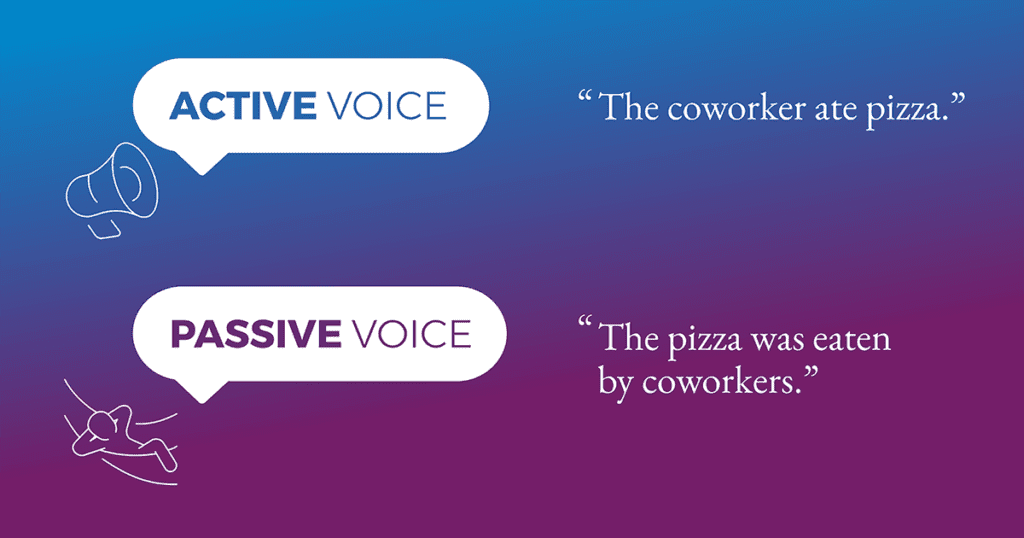You’ve probably heard the old writers’ joke that “passive voice is to be avoided,” but has anyone ever explained why (or why that’s even funny)?
If you want to write or edit compelling, engaging blogs, emails, and marketing copy, be deliberate in your word choices. Communication choices should also be a standardized part of your brand, and this might easily include creating some active voice taglines or establishing a tone of voice by leaning into active voice commands, for example. Subtle differences can sometimes have big impacts.
Here is a simple guide to active and passive voice to sharpen your business writing and better connect with your audience.
Essentially, the difference between active vs. passive voice is where the subject is placed within the sentence.
If you remember the days of diagramming sentences in grade school, you’ll recall that the subject of a sentence is the person, place, or thing performing an action. Think of the subject as the sentence’s “main character.”
In an active sentence like The cow jumped over the moon, the subject, the cow, performs the action of jumping. Passive voice, on the other hand, turns this structure on its head so that the subject is receiving the action. The passive version of this sentence, The moon was jumped over by the cow, doesn’t exactly roll off the tongue.
Here are a few more examples of active and passive sentences:
Active: The coworkers ate pizza.
Passive: The pizza was eaten by coworkers.
Active: Someone didn’t shut the gate.
Passive: The gate didn’t get shut.
Active: I fed the dogs.
Passive: The dogs were fed.
As you can see, some examples of passive voice sound extremely awkward, while others feel pretty grammatically normal.
So, how can you determine which is best for the content you’re creating?
In general, marketing copywriters favor active voice.
Though there are certainly situational and stylistic exceptions, most copywriters share the goal of connecting with audiences and taking them on a journey with their words. Notice some common trends in the passive versions of the sentences above. Passive voice tends to:
Writing that is enjoyable to read is easily digestible, concise, and includes a good variety of sentence lengths and structures. It’s often difficult to achieve this with passive voice.
Using active voice is a great way to sharpen your writing, improve clarity, and ultimately reduce webpage abandonment.
When it comes to creating content, active voice offers two main advantages. First, it gets right to the point — something that is critically important for copywriters who are fighting to hook their audience and keep them reading. Second, it makes your audience the main character of the story you’re telling.
Marketing emails and landing page copy may not feel like stories in the traditional sense, but approach it this way:
Active voice moves your story forward and puts your audience in the driver’s seat. Struggling to make sandwiches? Try sliced bread! sounds a lot more concise, audience-focused, and empowering than Is making sandwiches a struggle for you? Sliced bread should be tried!
Successful marketing copy includes a call to action, or CTA. What do you want your reader to do next?
Read more.
Shop now.
Join our mailing list.
Whether you hope they will make a purchase, subscribe to your content, or fill out a contact form, CTAs are typically command sentences. Active voice is particularly important for CTAs because you’re asking your reader to take action. Clarity and urgency improve your likelihood of success.
Choosing to write in active voice can indirectly improve your search rankings — a primary goal for most landing pages and blogs. You’ll also find that ad copy for Google Ads and social media ads benefits from concise information and commands.
Active voice improves readability and makes it easier to match target keywords. Think about the kinds of things your intended audience is typing into a search engine. The better you reflect those terms and their synonyms in your copywriting, the more likely you are to capture clicks.
All of this being said, passive voice still has a purpose! English teachers and grammar software routinely flag passive voice, but that doesn’t mean it doesn’t have its rightful place in language. Here are a few common situations where writers may make a deliberate choice to use passive voice.
Passive voice de-emphasizes the subject of a sentence, which isn’t always a bad thing. If you’re telling a story with missing information or trying to minimize a subject’s role in the action, passive voice is the way to go.
Example: The Lindbergh baby was kidnapped.
Sometimes, the subject of a sentence is immaterial. Passive voice is very common in scientific and technical writing when it’s more important to explain a process than identify who carried it out.
Example: The test tubes were removed from the centrifuge.
If you want to keep your readers’ attention on the action, passive voice can help. Journalists sometimes intentionally choose passive voice when reporting on events.
Example: The suspect was indicted by the grand jury.